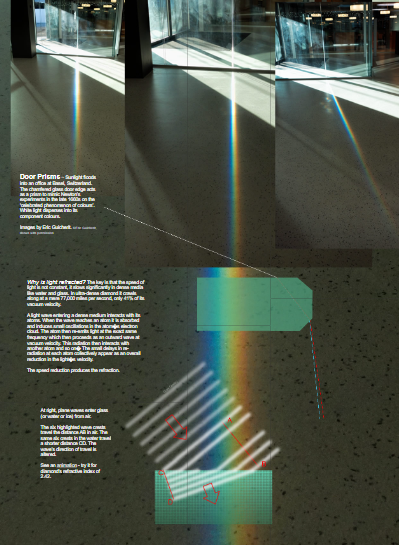Refraction, Door Prisms - OPOD
Refraction: Exploring the Phenomenon of Light
Have you ever wondered why light bends when it passes through certain materials? The answer lies in a fascinating phenomenon called refraction. The speed of light is not constant; it slows down significantly in dense media like water and glass. In fact, in ultra-dense diamond, light crawls along at a mere 77,000 miles per second, which is only 41% of its velocity in a vacuum.
So, how does this slowing down of light lead to refraction? When a light wave enters a dense medium, it interacts with the atoms of that medium. As the wave reaches an atom, it gets absorbed and induces small oscillations in the atom's electron cloud. The atom then re-emits light at the exact same frequency, which propagates as an outward wave at the speed of light in a vacuum. However, the delays in re-radiation at each atom collectively result in an overall reduction in the velocity of the light wave.
This reduction in speed is what causes refraction to occur. When plane waves of light enter a medium like glass, water, or ice from air, the wave crests travel different distances in the two media. For example, if we consider six highlighted wave crests traveling in air from point A to point B, those same crests in water would travel a shorter distance from point C to point D. This change in distance alters the direction of travel for the wave, resulting in refraction.
To visualize this concept more clearly, you can refer to an animation that demonstrates the effect of refraction for different refractive indices. For instance, if we take diamond with a refractive index of 2.42, you can observe how the bending of light occurs as it enters the diamond.
The phenomenon of refraction is not only scientifically intriguing but also has practical applications. It is thanks to refraction that we are able to use lenses in our everyday lives. Lenses are designed to exploit the bending of light to focus or diverge it, allowing us to see clearly or magnify objects. Cameras, telescopes, microscopes, and eyeglasses all rely on the principles of refraction to enhance our vision and understanding of the world.
Moreover, refraction is responsible for some breathtaking natural optical phenomena. The dispersion of white light into its component colors, as observed in rainbows or when light passes through a prism, is a result of refraction. The different wavelengths of light bend at slightly different angles, creating the beautiful spectrum of colors we see.
In conclusion, refraction is a captivating phenomenon that occurs when light passes through a medium with a different optical density. The slowing down of light in dense media causes it to change direction, leading to the bending of light rays. This phenomenon has significant implications in various fields, from the design of optical instruments to the creation of stunning natural displays. Understanding refraction allows us to appreciate the intricate ways in which light interacts with matter and shapes our perception of the world around us.

Door Prisms ~ Sunlight floods into an office at Basel, Switzerland. The chamfered glass door edge acts as a prism to mimic Newton’s experiments in the late 1660s on the ‘celebrated phenomenon of colours’. White light disperses into its component colours.
Images by Eric Guicherit. ©Eric Guicherit, shown with permission
Why is light refracted? The key is that the speed of light is not constant, it slows significantly in dense media like water and glass. In ultra-dense diamond it crawls along at a mere 77,000 miles per second, only 41% of its vacuum velocity.
A light wave entering a dense medium interacts with its atoms. When the wave reaches an atom it is absorbed and induces small oscillations in the atom�s electron cloud. The atom then re-emits light at the exact same frequency which then proceeds as an outward wave at vacuum velocity. This radiation then interacts with another atom and so on� The small delays in re-radiation at each atom collectively appear as an overall reduction in the light�s velocity.
The speed reduction produces the refraction.
At right, plane waves enter glass (or water or ice) from air.
The six highlighted wave crests travel the distance AB in air. The same six crests in the water travel a shorter distance CD. The wave’s direction of travel is altered.
See an animation - try it for diamond's refractive index of 2.42.
Note: this article has been automatically converted from the old site and may not appear as intended. You can find the original article here.
Reference Atmospheric Optics
If you use any of the definitions, information, or data presented on Atmospheric Optics, please copy the link or reference below to properly credit us as the reference source. Thank you!
-
<a href="https://atoptics.co.uk/blog/refraction-door-prisms-opod/">Refraction, Door Prisms - OPOD</a>
-
"Refraction, Door Prisms - OPOD". Atmospheric Optics. Accessed on November 26, 2024. https://atoptics.co.uk/blog/refraction-door-prisms-opod/.
-
"Refraction, Door Prisms - OPOD". Atmospheric Optics, https://atoptics.co.uk/blog/refraction-door-prisms-opod/. Accessed 26 November, 2024
-
Refraction, Door Prisms - OPOD. Atmospheric Optics. Retrieved from https://atoptics.co.uk/blog/refraction-door-prisms-opod/.